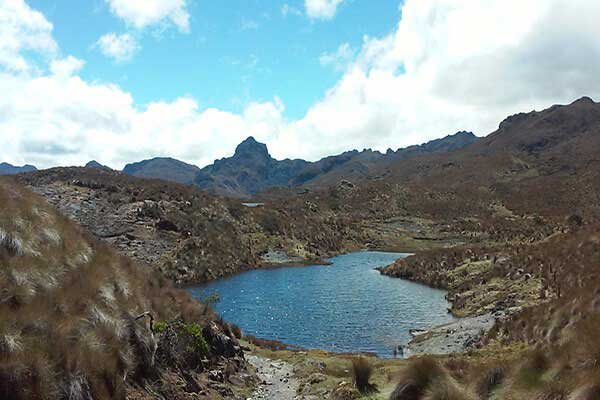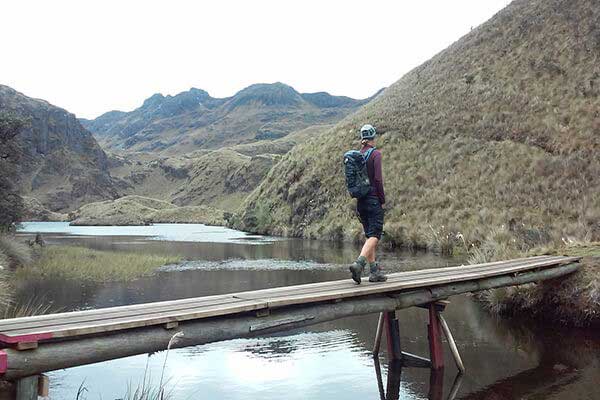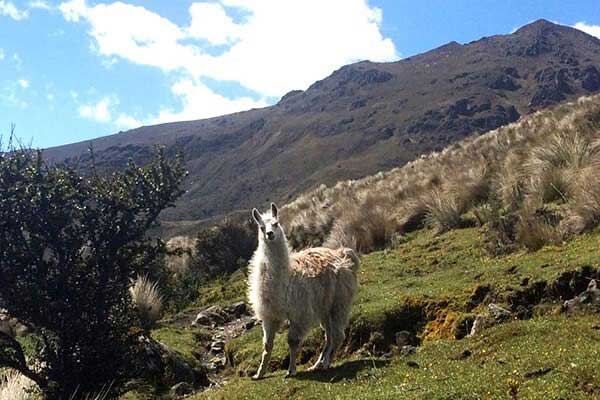It’s true that many people visit or move to Cuenca because they are seduced by its UNESCO-recognized colonial center, its year-round pleasant climate, and its relatively low cost of living. But just outside the city limits, Cuenca’s backyard is one of dramatic mountains and stunning Andean páramo vistas, making the area an absolute mecca for outdoor enthusiasts. Mountain biking, hiking, horse riding, rock climbing, fly fishing, trail running, and even paragliding are some of the many adventure activities that can be indulged in when living in or just visiting Cuenca. As lifelong lovers of the outdoors, one of the main reasons my husband and I chose the city as our new home in 2019 was its proximity and easy access to Cajas National Park. This rugged, alpine tundra landscape is arguably the crown jewel of the spectacular countryside surrounding Ecuador’s third-largest city, but a surprising number of people we’ve met–expats and locals alike–have never taken the time to hike in, or just visit, this protected area of natural beauty.
The park–Parque Nacional Cajas in Spanish–is a high-altitude wetland, comprising of more than 4,000 bodies of water, and is the source of two of the four rivers that flow through Cuenca–the Tomebamba and the Yanuncay. This abundance of water acts as a resting spot for many migratory birds, and also provides drinking water for surrounding communities, including Cuenca. Cajas National Park is located almost 22 miles to the west of the city, and its peaks are clearly visible from town on a sunny day. The altitude within the park’s borders ranges from approximately 10,300 to 14,600 feet, and temperatures plunge below 30 F at night due to this extreme elevation. Boasting numerous well-marked trails and tranquil camping spots, it is an ideal place for day hikes, bird watching, photography, rock climbing, and extended backpacking expeditions. The park is also an angler’s dream: many lakes are accessible to fly fishing and no permit is currently required. Simply bring your own equipment and fish for trout to your heart’s content!

If not traveling by car, the easiest way to reach Cajas is to take any Guayaquil-bound bus from Cuenca. These buses depart about every 30 to 40 minutes from the city’s main bus station, Terminal Terrestre, and will drop you off at Laguna la Toreadora, where the park’s main entrance and visitor’s center are situated. It’s a lovely, scenic drive, taking about 45 minutes, but a word of warning: although the scenery is mesmerizing, you will probably have to endure the auditory assault of a “shoot-em-up” Hollywood movie, dubbed into Spanish and played at full volume, as part of the onboard entertainment!
A ranger’s station is located just a couple hundred yards down a dirt road from the bus drop-off point, and here rangers provide hikers with a printed map outlining the main hikes, camping spots, fishing locations, and other points of interest within the park. The rangers are extremely knowledgeable about all aspects of the park and encourage anyone setting out on the trails to register passport details with them, for safety reasons. Next to the refuge is a visitor’s center, where there is interesting information about the flora and fauna in the park, and–perhaps most importantly–a small café, with wonderful views of the mountains, serving excellent hot chocolate and tasty snacks.
Laguna la Toreadora and the above-mentioned facilities are on the north side of the highway, and this is the part of the park that is most visited. Like most places in Ecuador, it can be busy on weekends and national holidays, but during the week it is generally very peaceful. There are three established, well-marked hikes on this side of the highway–two of them starting from the lake, and the third from a little higher up along the highway. If you’re not used to hiking at altitude, the air can feel very thin, and everything is more tiring, even walking on level ground, so it’s a good idea to set yourself modest goals.

Our favorite hiking itinerary is to combine routes 1 and 2, which makes for a strenuous six-hour loop, and includes a lung-burning climb up to just under 14,000 feet. This route passes through a variety of landscapes: from the rocky, exposed summit of Cerro San Luis to a small, dark forest of “paper trees” (árboles de papel), which provide shelter from the wind and create an eerie sensation of stillness–rather like that of first snowfall. The many lakes and creeks make for perfect picnicking spots, and if the weather cooperates, it makes a great day’s hike with superb vistas in every direction.
All hikers should, however, come dressed for high mountain conditions, i.e., cold wind, rain, hail, fog–the weather here, like anywhere in the Andes, can change very suddenly and many hikers have become disoriented in white-outs. The wetland ecosystem also means that the ground can be soggy underfoot in some places, so a good pair of waterproof hiking boots is highly recommended. And as with any mountain hiking, it’s a good idea to start out early for a better chance of having decent weather. The park officially closes at 4:30 p.m. every day, although you can still exit on foot after this time. Bear in mind that darkness falls at around 6:30 p.m. year round, so aiming for an earlier finish time is a wise precaution.

For those who are not interested in hiking, it is still a worthwhile daytrip to just visit the lake, take some photos, and perhaps relax at the café, sipping a hot chocolate as you enjoy the panoramic views. Cajas truly is a stunning landscape of craggy peaks, pristine lakes, and small waterfalls. You might even be lucky enough to glimpse an Andean condor flying overhead, or spot a laid-back llama chewing grass right outside the café window. Most importantly, your lungs will feel cleansed by the clean mountain air and you´ll have a spring in your step when you get back to town. Returning to Cuenca is just as easy as arriving–simply cross over to the south side of the highway and wait for any Cuenca-bound bus to take you back to the city. Or hop on a Guayaquil-bound bus to head down to the coast for some well-deserved oxygen! Whether you live in Cuenca, or are just passing through, it is well worth taking a day away from the city’s myriad of attractions to discover the beauty and tranquility of Cajas National Park.
[ecuador_signup]
Related Articles
Move to Ecuador for Its Wealth of Charms
5 Reasons To Move to Cuenca… And 2 Not To
Two Weeks in Ecuador: Touring Quito, Cuenca, and Salinas
[post_takeover]
[lytics_best_articles_collection]

